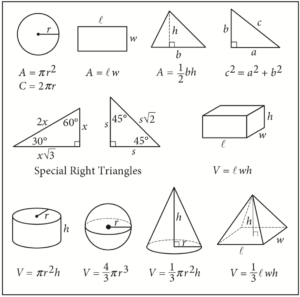1. Directions
For questions 1 through 15, solve each problem, choose the best answer from the choices provided, and indicate your answer choice on your answer sheet. For questions 16 through 20, solve the problem and indicate your answer, which is to be recorded in the spaces provided on the answer sheet. Please refer to the directions before question 16 on how to record your answers in the spaces provided. You may use scratch paper for scratch work.
Notes
1. The use of a calculator is not permitted.
2. All variables and expressions used represent real numbers unless otherwise indicated.
3. Figures provided in this test are drawn to scale unless otherwise indicated.
4. All figures lie in a plane unless otherwise indicated.
5. Unless otherwise indicated, the domain of a given function f is the set of all real numbers x for which f (x) is a real number.
Reference

Begin skippable figure descriptions.
The figure presents information for your reference in solving some of the problems.
Reference figure 1 is a circle with radius r. Two equations are presented below reference figure 1.
A equals pi times the square of r.
C equals 2 pi r.
Reference figure 2 is a rectangle with length ℓ and width w. An equation is presented below reference figure 2.
A equals ℓ w.
Reference figure 3 is a triangle with base b and height h. An equation is presented below reference figure 3.
A equals onehalf b h.
Reference figure 4 is a right triangle. The two sides that form the right angle are labeled a and b, and the side opposite the right angle is labeled c. An equation is presented below reference figure 4.
c squared equals a squared plus b squared.
Special Right Triangles
Reference figure 5 is a right triangle with a 30degree angle and a 60degree angle. The side opposite the 30degree angle is labeled x. The side opposite the 60degree angle is labeled x times the square root of 3. The side opposite the right angle is labeled 2 x.
Reference figure 6 is a right triangle with two 45degree angles. Two sides are each labeled s. The side opposite the right angle is labeled s times the square root of 2.
Reference figure 7 is a rectangular solid whose base has length ℓ and width w and whose height is h. An equation is presented below reference figure 7.
V equals ℓ w h.
Reference figure 8 is a right circular cylinder whose base has radius r and whose height is h. An equation is presented below reference figure 8.
V equals pi times the square of r times h.
Reference figure 9 is a sphere with radius r. An equation is presented below reference figure 9.
V equals fourthirds pi times the cube of r.
Reference figure 10 is a cone whose base has radius r and whose height is h. An equation is presented below reference figure 10.
V equals onethird times pi times the square of r times h.
Reference figure 11 is an asymmetrical pyramid whose base has length ℓ and width w and whose height is h. An equation is presented below reference figure 11.
V equals onethird ℓ w h.
End skippable figure descriptions.
Additional Reference Information
The number of degrees of arc in a circle is 360.
The number of radians of arc in a circle is 2 pi.
The sum of the measures in degrees of the angles of a triangle is 180.
Question 1 is based on the following two equations.
2x – y = 8
x + 2y = 4
Question 1.
For the preceding system of equations, what is the value of x + y?